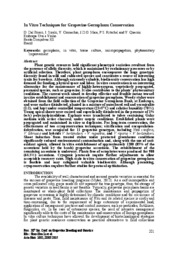In Vitro techniques for grapevine germplasm conservation.
In Vitro techniques for grapevine germplasm conservation.
Author(s): BOSCO, D. D.; SINSKI, I.; COMACHIO, V.; MAIA, J. D. G.; RITSCHEL, P. S.; QUECINI, V.
Summary: Abstract Plant genetic resources hold significant phenotypic variation resultant from the presence of allelic diversity, which is maintained by evolutionary processes or by artificial selection. Therefore, plant germplasm encompasses the huge genotypic diversity found in wild and cultivated species and constitutes a source of interesting traits for breeders. Although extremely valuable, biodiversity conservation has high demand for funding, physical space and labor. In vitro conservation is an interesting alternative for the maintenance of highly-heterozygous, vegetatively propagated, perennial species, such as grapevine. It also contributes to the plants? phytosanitary conditions. The current work aimed to develop effective and feasible means toward in vitro establishment and conservation of grapevine germplasm. Woody stakes were obtained from the field collection of the Grapevine Germplasm Bank, at Embrapa, and were surface disinfected, planted in a mixture of autoclaved soil and vermiculite (1:1), and kept under controlled temperature (23±5°C) and relative humidity (70%). Young apical shoots were excised and superficially disinfected in the presence of 1% (w/v) polyvinylpirrolidone. Explants were transferred to tubes containing Galzy medium with active charcoal, under aseptic conditions. Established plants were propagated and maintained in vitro as duplicates. For long-term conservation, the effectiveness of two cryopreservation techniques; vitrification and encapsulationdehydration, was compared for 11 grapevine genotypes, including Vitis vinifera, V. labrusca and hybrids V. berlandieri × V. rupestris, and V. riparia × V. berlandieri. Shoot induction from treated stakes under protected greenhouse conditions significantly reduced environmental contamination and, along with the use of antioxidant agents, allowed in vitro establishment of approximately 1200 (85% of the accessions held by the bank) grapevine accessions. The establishment of the remaining accessions is underway. Plants free of ectophytes were produced for 900 (64.3%) accessions. Cryogenic protocols require further adjustments to allow acceptable recovery rates. High-scale in vitro conservation of grapevine germplasm is feasible and may safeguard valuable biodiversity. Although promising, cryopreservation requires further studies for protocol optimization.
Publication year: 2015
Types of publication: Journal article
Unit: Embrapa Grape & Wine
Keywords: Germplasm, In vitro, Micropropagation, Phytosanitary improvement, Tissue culture
Observation
Some of Embrapa's publications are published as ePub files. To read them, use or download one of the following free software options to your computer or mobile device. Android: Google Play Books; IOS: iBooks; Windows and Linux: Calibre.
Access other publications
Access the Agricultural Research Database (BDPA) to consult Embrapa's full library collection and records.
Visit Embrapa Bookstore to purchase books and other publications sold by Embrapa.

